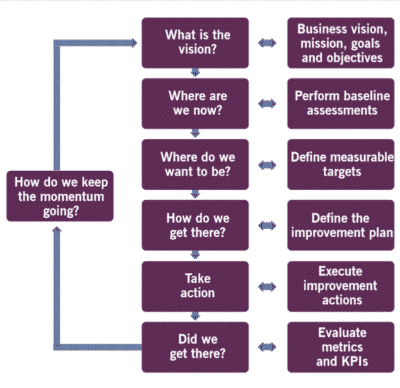AXELOS is about to release the new ITIL Maturity Model. In this blog, OwlPoint answers common questions about the new Capability and Maturity Model updated for ITIL 4 as well as the related ITIL Assessment services.
What is the ITIL Maturity Model?
The ITIL® maturity model is a tool that organizations can use to objectively and comprehensively assess their service management capabilities and the maturity of the organization’s Service Value System (SVS).
What is the difference between the ITIL Maturity Model and an ITIL Assessment?
The ITIL Maturity Model establishes the criteria to achieve each level of maturity of the Service Value System and the capability of each of the 34 ITIL 4 Practices. The ITIL Assessment is a process of evaluating an organization against a specific set of practices and usually the organization’s adoption of a Service Value System using the criteria established by the ITIL Maturity Model.
What are the different types of ITIL Assessments?
There are 3 types of assessments that have been defined by AXELOS. They are:
- Comprehensive Assessment – The evaluation of 7 or more practices as well as the components of the ITIL Service Value System
- Capability Assessment – The assessment of selected practices but does not include the SVS components
- Maturity Assessment – The review of the SVS components and up to 6 practices

What is AXELOS?
AXELOS is the organization responsible for developing, enhancing and promoting a number of best practice frameworks and methodologies used globally by professionals working primarily in IT service management and project management. They are the governing body who owns and is responsible for ITIL.
Who can perform an ITIL Assessment?

Only AXELOS Consulting Partners’ (ACPs) qualified ITIL Assessors can conduct an ITIL Assessment that uses the official ITIL 4 Maturity Model. OwlPoint is one of the few organizations qualified to conduct ITIL Assessments
Where can I find an ACP to conduct an ITIL Assessment?

OwlPoint is the most tenured AXELOS Consulting Partner in the US and has been a contributor to the ITIL Maturity Model. Please schedule an appointment to talk to one of our qualified ITIL Assessors or send us an email at ITILMaturityAssessment@owlpoint.com.
Our IT Service Management implementation is based on ITIL 3. Should we implement ITIL 4 before having an assessment?
You should not wait until implementing ITIL 4 before having an assessment. Knowing where you currently are in terms of maturity and capability will help identify areas of focus to optimize your IT Service Management Organization improvements. Many of your ITIL v3 capabilities will translate to ITIL 4.
Do I have to have all 34 Practices evaluated during an ITIL Assessment?
It is not required to have all 34 Practices’ capabilities assessed as part of an ITIL Assessment. You may have any number of practices assessed. However, the Continual Improvement practice is always included in an assessment.
Why must the Continual Improvement Practice be included in all ITIL Assessments?
The purpose of Continual Improvement is to ensure service and products align – and remain aligned – to the Business continuously. It is one of the five components of the Service Value System.

What are the Capability Levels defined in the ITIL Maturity Model?
The new reference model defines the following capability levels:
- Level 0: The practice lacks any basic capability; its purpose is not achieved
- Level 1: The practice is not well organized; it’s performed as initial/intuitive. It may occasionally or partially achieve its purpose through an incomplete set of activities
- Level 2: The practice systematically achieves its purpose through a basic set of activities supported by specialized resources
- Level 3: The practice is well defined and achieves its purpose in an organized way, using dedicated resources and relying on inputs from other practices that are integrated into a service management system
- Level 4: The practice achieves its purpose in a highly organized way, and its performance is continually measured and assessed in the context of the service management system
- Level 5: The practice is continually improving organizational capabilities associated with its purpose

What are the SVS Maturity Levels defined in the ITIL Maturity Model?
The Maturity Model defines the following maturity levels:
- Level 1 – Initial: Work is completed, but the purpose and objectives of the SVS in scope are not always achieved
- Level 2 – Managed: Planning and performance measurement take place, and the purpose and objectives of the SVS in scope are repeatedly achieved, although not in a standardized way
- Level 3 – Defined: Organization-wide standards provide guidance across the SVS
- Level 4 – Quantitative: The SVS is data driven, with quantitative performance improvement
- Level 5 – Optimizing: The SVS is optimized and focused on continual improvement
Why is a Maturity Assessment important?
An ITIL Maturity Assessment provides you the information needed to establish a baseline for your continual improvement needs as well as measure yourself after improvement plans have been implemented. Assessments are a critical component to every continual improvement program.
How is an ITIL Practice evaluated during an ITIL Assessment?
An ACP’s ITIL Assessor will use a combination of documentation review, interviews, and observation to evaluate an organization’s capabilities as defined in the new reference model. Based on the completion of all the criteria established in the Maturity Model for a particular practice’s level, the capability score will be assigned.
How is the Service Value System evaluated during an ITIL Assessment?
An ACP’s ITIL Assessor will use a combination of documentation review, interviews, and observation to evaluate an organization’s maturity as defined in the ITIL Maturity Model. Based on the completion of all the criteria established in the model for the 5 Service Value System components, the maturity score will be assigned. The overall maturity is assigned by the lowest number achieved for the 5 SVS components.
Do you still have questions about the ITIL Maturity Model or the ITIL Assessment that we have not answered? Feel free to ask questions by sending an email to ITILMaturityAssessment@OwlPoint.com or schedule an appointment to talk to one of our qualified ITIL Assessors.

